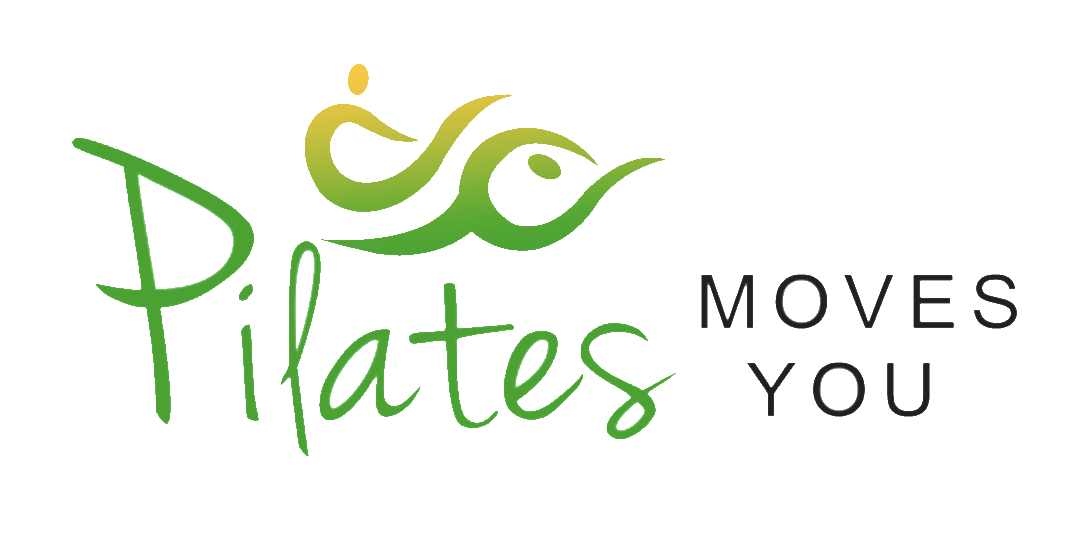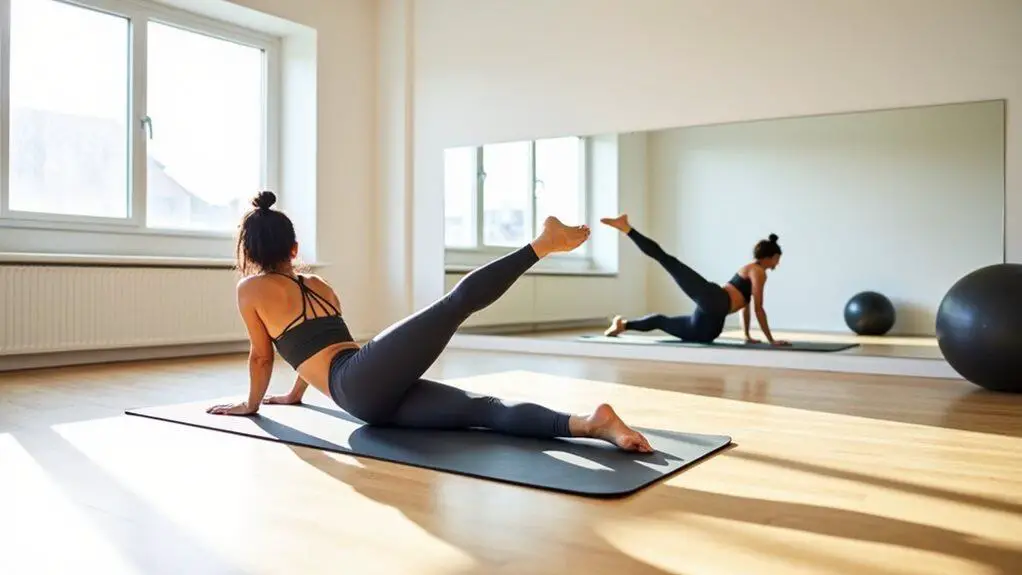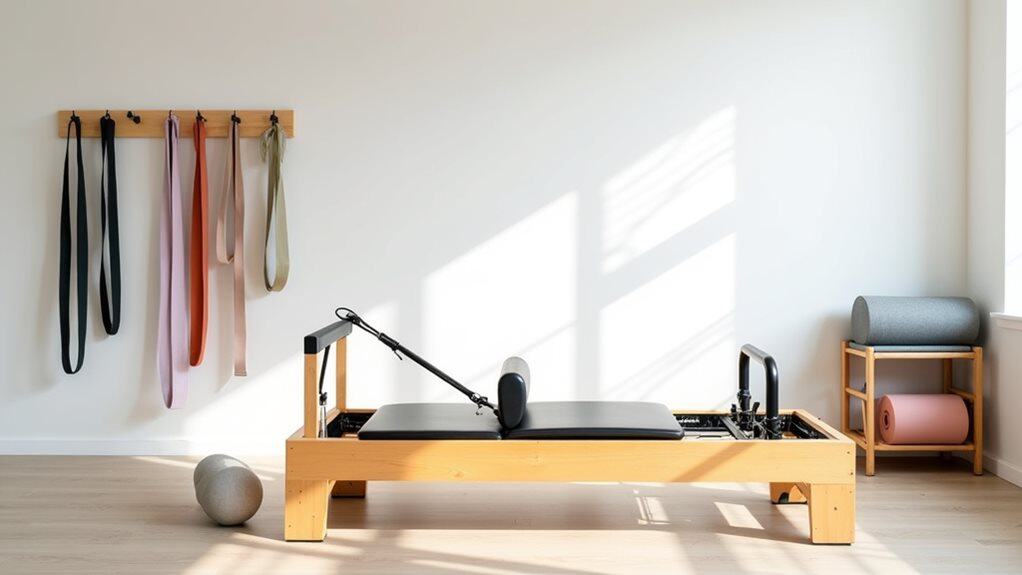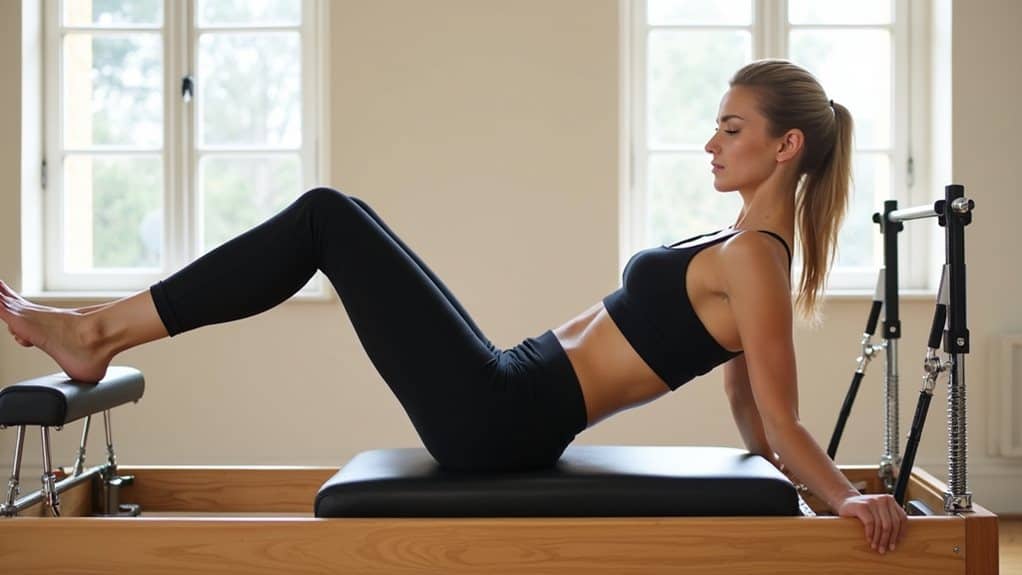Are you expecting a little bundle of joy and wondering if you can still do Pilates?
You can do Pilates while pregnant. However, it is important to consult with your healthcare provider and find a qualified prenatal Pilates instructor who can guide you through safe modifications and exercises that are suitable for your stage of pregnancy.
Pilates can be a safe and beneficial exercise option during pregnancy, but there are a few things you need to keep in mind. Before starting any exercise program, it’s important to consult with your doctor, especially if you have any specific risk factors or complications.
Certain precautions and adaptations may be necessary to ensure your safety and the well-being of your baby. In this article, we will explore the safety and benefits of doing Pilates during pregnancy, as well as provide you with tips and recommendations for practicing Pilates at home.
So, let’s dive in and find out how you can stay active and maintain a healthy pregnancy with Pilates!
Pilates during pregnancy: Can it be done?
Yes, you can absolutely do Pilates while pregnant, and it can be a wonderful way to stay active and healthy during this special time! There are some common myths surrounding exercising during pregnancy, but Pilates can be safely practised with proper modifications.
Many Pilates exercises can be adapted to accommodate your growing belly and changing body. Your instructor can guide you on the appropriate modifications to ensure your safety and comfort.
One important area to focus on during pregnancy is the pelvic floor. Pilates can help strengthen these muscles, which can be beneficial during pregnancy and for postpartum recovery. Additionally, Pilates can be a great way to alleviate morning sickness symptoms. The focus on breathing and gentle movements can help reduce nausea and promote a sense of calm.
Speaking of post-partum recovery, Pilates can play a crucial role in rebuilding strength and fitness, especially for your core muscles. It’s important to consult with your doctor before starting any exercise program post-partum, but Pilates can be an effective and safe choice for many women.
Now, let’s move on to the next section about safety and precautions during Pilates while pregnant.
Safety and Precautions
Ensure your safety and protect your precious baby by following these important precautions when practising Pilates during your pregnancy. While Pilates can be a safe and effective form of exercise during pregnancy, it’s crucial to be aware of potential risks and take necessary precautions.
Before starting any exercise program, consult with your healthcare provider, especially if you have any pre-existing conditions or risk factors. Your healthcare provider will assess any risks or complications based on your specific circumstances, like your stage of pregnancy and any existing medical conditions.
It is important to choose a qualified prenatal Pilates instructor who has expertise and experience in working with pregnant women. They will be able to modify exercises and tailor the workout according to your specific needs and limitations.
When practising Pilates during pregnancy, it’s essential to maintain proper form and alignment to avoid any strain or injury. Focus on engaging your core muscles and pelvic floor while performing the exercises.
Avoid any movements that cause discomfort or pain and be cautious when getting up from lying down or changing positions to prevent dizziness or lightheadedness.
Certain positions and exercises should be avoided during pregnancy to ensure the safety of both you and your baby.
It’s recommended to avoid exercises done on your back after the first trimester to prevent pressure on the vena cava. Modify positions such as lying flat on your back by using props or positioning yourself on an incline.
Monitoring the intensity of your workouts is also crucial during pregnancy. Listen to your body and make sure not to overexert yourself. Take breaks when needed and stay hydrated throughout your Pilates sessions. Remember, it’s important to balance your Pilates practice with other forms of exercise on days when you’re not doing Pilates.
Body Temperature
It’s important to pay attention to body temperature. High temperatures can pose risks to both the baby and the mother, leading to tiredness and an increased likelihood of accidental injury.
To ensure a healthy and safe pregnancy exercise routine, pregnant women should avoid practising Pilates in hot or humid environments. It’s crucial to maintain a moderate intensity and avoid overheating. This means choosing a well-ventilated space and wearing comfortable clothing that allows for proper air circulation.
Signs of overheating to watch out for during exercise include feeling excessively hot, dizziness, shortness of breath, rapid heartbeat, and intense fatigue. If any of these symptoms are experienced, it’s important to take a break, hydrate, and cool down.
By paying attention to body temperature, pregnant women can ensure a safe and enjoyable Pilates workout. Remember to stay hydrated, take breaks when needed, and listen to your body, and you can enjoy the numerous benefits that Pilates offers during pregnancy.
Benefits during Pregnancy
Experience the incredible benefits of Pilates during pregnancy as it supports your overall well-being and prepares your body for the beautiful journey of motherhood. Pilates is a safe and effective exercise option for expectant mothers, offering numerous advantages that can enhance your pregnancy experience. Here are some of the benefits you can expect:
- Reducing back pain: Pilates focuses on strengthening the core muscles, which can help alleviate back pain commonly experienced during pregnancy.
- Improving energy levels: Regular Pilates practice can boost your energy levels and combat fatigue, allowing you to better cope with the physical demands of pregnancy.
- Preventing complications: Pilates promotes proper posture and alignment, reducing the risk of complications such as pelvic pain or diastasis recti.
- Easing labor: The breathing techniques and pelvic floor exercises in Pilates can help prepare your body for labor, making it easier and more efficient.
- Promoting overall well-being: Pilates promotes relaxation, reduces stress, and improves mental well-being, which are all crucial during pregnancy.
One major advantage is its focus on strengthening the pelvic floor muscles. As the baby grows, the pelvic floor muscles can weaken and result in uncomfortable symptoms such as urinary incontinence. By practising Pilates exercises that target the pelvic floor, pregnant women can enhance muscle tone and support, reducing the risk of these issues.
In addition to pelvic floor strength, Pilates helps promote optimal blood circulation. The gentle and controlled movements in Pilates stimulate blood flow, which can alleviate swelling in the legs and ankles commonly experienced during pregnancy. This increased circulation also helps deliver oxygen and nutrients to both the mother and her baby.
And of course Pilates improves flexibility, which is essential for a healthy delivery process. Stretching exercises in Pilates help maintain or even increase the range of motion in joints and muscles, reducing the likelihood of strains or injuries during labour and childbirth.
Incorporating Pilates into a prenatal exercise routine offers many advantages. It is a low-impact form of exercise that is safe for most pregnant women, improving overall fitness and core strength without putting excessive stress on the body. Pilates also focuses on breathing techniques, which can help manage shortness of breath, a common symptom during pregnancy.
Adaptations and Modifications
Prenatal modifications are essential to accommodate the changes happening in your body during pregnancy. Safe Pilates exercises can be performed with the guidance of a qualified instructor who’s knowledgeable about prenatal adaptations.
These modifications may include adjusting the range of motion, avoiding exercises that put too much pressure on the abdomen, and using props for added support.
In the early stages of pregnancy, it’s generally safe to continue your pre-pregnancy exercise routine, as long as you feel comfortable doing so. However, as pregnancy progresses, certain modifications may be necessary.
High-intensity workouts during pregnancy can pose potential risks and complications. These include an increased risk of preterm labour and the development of gestational diabetes.
Low-impact exercises, such as walking, swimming, or prenatal yoga, are often recommended, as they reduce stress on the joints and minimize the risk of injury.
One important modification to keep in mind is avoiding supine positions, where you lie on your back, from the beginning of the second trimester onwards. This is to prevent pressure on the vena cava, a large vein that can be compressed, compromising blood flow to both you and your baby. Instead, focus on exercises that can be done in a seated, standing, or side-lying position.
Breathing techniques during pregnancy are also emphasized in Pilates. Learning proper breathing techniques can help you relax, manage stress, and provide oxygen to your growing baby. Incorporating deep, diaphragmatic breathing into your Pilates practice can enhance the mind-body connection and promote a sense of calmness.
If you’re familiar with the Pilates Reformer, it can still be used during pregnancy with appropriate adaptations.
Your instructor can modify the exercises to ensure your safety and comfort, such as adjusting spring tensions and providing additional support. Always consult with your healthcare provider and seek guidance from a qualified prenatal Pilates instructor before using any Pilates equipment.
Recommended Duration and Frequency
Maintaining an appropriate duration and frequency of prenatal Pilates sessions is crucial for a balanced and effective workout routine during pregnancy. When it comes to exercise intensity, it’s recommended to aim for moderate-intensity workouts. This means that you should feel slightly out of breath but still able to carry on a conversation.
Incorporating rest days into your Pilates routine is essential to allow your body to recover and prevent overexertion. As for Pilates class options, there are various options available, including in-person group classes, private sessions, or even online classes that can be done in the comfort of your own home.
It’s important to balance your Pilates sessions with other forms of exercise to ensure a well-rounded fitness routine. Consider your individual fitness levels and any specific recommendations from your healthcare provider when determining the appropriate duration and frequency of your Pilates sessions.
It’s always recommended to consult with your doctor before starting or continuing any exercise program during pregnancy to ensure it’s safe for you and your baby’s health.
Consultation with a Doctor
It’s been mentioned a few times, but it’s worth repeating as it’s especially important during pregnancy that you consult with your doctor to ensure the safety and well-being of both you and your baby.
Your healthcare provider will be able to assess your individual health status and provide you with appropriate guidance based on any potential risks and contraindications. They may also have specific medical clearance requirements that need to be met before engaging in any exercise routine.
Regular communication with your healthcare provider throughout your pregnancy is crucial. It allows them to monitor your progress, address any concerns or complications that may arise, and make any necessary adjustments to your exercise plan. They can also provide you with important information to help you navigate your pregnancy journey safely and healthily.
It’s important to attend regular check-ups with your healthcare provider to ensure that both you and your baby are progressing well. These check-ups allow for the monitoring of your overall health, the growth and development of your baby, and the detection of any potential issues that may require medical intervention.
By consulting with your doctor and maintaining open lines of communication, you can ensure a safe and healthy pregnancy journey. Once you’ve received medical clearance and guidance, you can move forward with confidence in your Pilates practice.
Now, let’s explore how you can incorporate Pilates equipment and home practice into your routine.
Equipment and Home Practice
Now that you’ve consulted with your doctor about doing Pilates during pregnancy, let’s explore the equipment and home practice options available to you.
- Choosing the right equipment: While mat Pilates is a popular choice during pregnancy, you may also consider using Pilates equipment such as the Pilates Reformer. This versatile piece of equipment can provide support and assistance as needed.
- Creating a safe and comfortable home practice: If you prefer to practice Pilates at home, creating a designated space with a comfortable mat or cushioned surface is essential. Ensure the area is well-lit and free from any hazards.
- Incorporating props and modifications: During pregnancy, certain exercises may need to be modified or avoided altogether. Incorporating props such as pillows, straps, or small weighted balls can provide additional support and help you adapt exercises to your changing body.
- Maintaining proper form and alignment: As with any exercise, maintaining proper form and alignment is crucial to prevent injury and maximize the benefits of Pilates. Focus on engaging your core, breathing deeply, and listening to your body’s cues.
- Finding online resources and tutorials: If you prefer to follow along with guided workouts, there are numerous online resources and tutorials available specifically tailored to pregnant women. These can provide you with a variety of exercises and modifications to suit your needs.
Now that you have a better understanding of equipment and home practice options, let’s move on to addressing specific concerns that may arise during your Pilates practice during pregnancy.
Addressing Specific Concerns
Let’s dive into how to address specific concerns that may come up during your Pilates practice during pregnancy!
One common concern is managing back pain, which can be alleviated through specific Pilates exercises that focus on strengthening the core and improving posture. Additionally, practicing Pilates can help prevent complications during pregnancy by promoting overall strength and stability.
It’s important to pay attention to breathing techniques during your Pilates workouts, as deep breathing can help relax the body and provide a sense of calm.
Another concern that many pregnant women have is rebuilding core strength after giving birth. Pilates exercises can be tailored to target the deep abdominal muscles, helping to gradually rebuild core strength.
Furthermore, Pilates can be beneficial for individuals experiencing sciatica pain during pregnancy. Specific exercises can help stretch and strengthen the muscles surrounding the sciatic nerve, providing relief.
Transitioning into the next section, let’s explore some tips and recommendations for a safe and effective Pilates practice during pregnancy.
Tips and Recommendations
Enhance your prenatal Pilates practice with these helpful tips and recommendations! During pregnancy, it’s important to focus on breathing techniques to promote relaxation and relieve stress.
Incorporate deep breathing exercises into your Pilates routine by inhaling deeply through the nose and exhaling fully through the mouth. This can help you stay calm and centered during your practice.
Core strengthening is another key aspect of prenatal Pilates. Engage and strengthen your core muscles to support your growing belly and help alleviate back pain. Focus on exercises that target your abdominal muscles, such as modified plank or seated twists. However, it’s essential to avoid any exercises that strain your abdomen or involve lying flat on your back.
Pelvic floor exercises are also crucial during pregnancy. Strengthening the pelvic floor muscles can help prevent issues like urinary incontinence and support the weight of your growing baby. Incorporate exercises like Kegels or pelvic tilts into your Pilates routine to strengthen these muscles.
In addition to core and pelvic floor exercises, don’t forget to include stretching and flexibility exercises in your prenatal Pilates practice. Gentle stretches can help relieve muscle tension and improve flexibility, which is beneficial during pregnancy and labour.
Lastly, keep in mind that prenatal Pilates can also contribute to postpartum recovery. By maintaining strength and flexibility throughout your pregnancy, you’ll be better equipped to regain your pre-pregnancy fitness level after giving birth. Just remember to consult with your doctor before resuming any exercise routine post-partum.
Incorporate these tips into your prenatal Pilates practice to help you stay healthy and active throughout your pregnancy journey. Remember to listen to your body, modify exercises as needed, and always prioritize safety and comfort.
Final Thoughts
Being pregnant is the start of a life long journey, a new chapter involving a brand new person. We all want to give our children the best life possible, and taking good care of ourselves isn’t always at the top of the list.
It’s vital you make time to care for yourself and give your body the movement it desires, and fortunatly you can start this practice with Pilates while pregnant.
It’s important to take certain precautions and adaptations. Consult with your doctor before starting any exercise program and be sure to address any specific concerns or risk factors.
With expert guidance and suitable adjustments, both Mat Pilates and Reformer Pilates can be conducted safely during pregnancy. Attending one to three one-hour Pilates classes per week, along with other forms of exercise on alternate days, is recommended.
Remember to listen to your body, make necessary adjustments, and enjoy the many benefits that Pilates can offer during pregnancy.
Congratulations and good luck!




